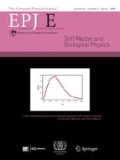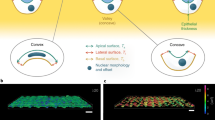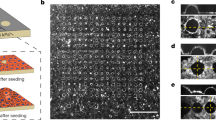Abstract
We measured the thickness of MDCK epithelia grown on substrates with a sinusoidal profile. We show that while at long wavelength the profile of the epithelium follows that of the substrate, at short wavelengths cells are thicker in valleys than on ridges. This is reminiscent of the so-called «healing length in the case of a thin liquid film wetting a rough solid substrate. We explore the ability of continuum mechanics models to account for these observations. Modeling the epithelium as a thin liquid film, with surface tension, does not fully account for the measurements. Neither does modeling the epithelium as a thin incompressible elastic film. On the contrary, the addition of an apical active stress gives satisfactory agreement with measurements, with one fitting parameter, the ratio between the active stress and the elastic modulus.
Graphic Abstract







Similar content being viewed by others
References
J. Salomon, C. Gaston, J. Magescas, B. Duvauchelle, D. Canioni, L. Sengmanivong, A. Mayeux, G. Michaux, F. Campeotto, J. Lemale, J. Viala, F. Poirier, N. Minc, J. Schmitz, N. Brousse, B. Ladoux, O. Goulet, D. Delacour, Nat. Commun. 8, 13998 (2017). https://doi.org/10.1038/ncomms13998
F.A. Maechler, C. Allier, A. Roux, C. Tomba, J. Cell Sci. 132, 22237jcs2 (2018). https://doi.org/10.1242/jcs.222372
J. Fouchard, T.P.J. Wyatt, A. Proag, A. Lisica, N. Khalilgharibi, P. Recho, M. Suzanne, A. Kabla, G. Charras, Proc. Natl. Acad. Sci. 117, 9377 (2020). https://doi.org/10.1073/pnas.1917838117
M. Luciano, S.L. Xue, W.H. De Vos, L. Redondo-Morata, M. Surin, F. Lafont, E. Hannezo, S. Gabriele, Nat. Phys. 17(12), 1382 (2021). https://doi.org/10.1038/s41567-021-01374-1
N. Harmand, A. Huang, S. Hénon, Phys. Rev. X 11(3), 031028 (2021). https://doi.org/10.1103/PhysRevX.11.031028
F. Brau, H. Vandeparre, A. Sabbah, C. Poulard, A. Boudaoud, P. Damman, Nat. Phys. 7(1), 56 (2011). https://doi.org/10.1038/nphys1806
C.L. Adams, Y.T. Chen, S.J. Smith, W.J. Nelson, J. Cell Biol. 142(4), 1105 (1998)
D.A. Herzlinger, T.G. Easton, G.K. Ojakian, J. Cell Biol. 93(2), 269 (1982). https://doi.org/10.1083/jcb.93.2.269
D. Sage, D. Prodanov, J.Y. Tinevez, J. Schindelin, p. 1 (2012)
P. de Gennes, F. Brochard-Wyart, D. Quere, Capillarity and Wetting Phenomena: Drops, Bubbles, Pearls, Waves (Springer, New York, 2003)
D. Andelman, J. Joanny, M. Robbins, Europhys. Lett. 7(8), 731 (1988). https://doi.org/10.1209/0295-5075/7/8/011
H. Honda, M. Tanemura, T. Nagai, J. Theor. Biol. 226(4), 439 (2004). https://doi.org/10.1016/j.jtbi.2003.10.001
E. Hannezo, J. Prost, J.F. Joanny, Proc. Natl. Acad. Sci. 111(1), 27 (2014). https://doi.org/10.1073/pnas.1312076111
M. Misra, B. Audoly, I.G. Kevrekidis, S.Y. Shvartsman, Biophys. J . 110(7), 1670 (2016). https://doi.org/10.1016/j.bpj.2016.03.009
G. Salbreux, G. Charras, E. Paluch, Trends Cell Biol. 22(10), 536 (2012). https://doi.org/10.1016/J.TCB.2012.07.001
P. Chugh, E.K. Paluch, J. Cell Sci. 131(14), jcs186254 (2018). https://doi.org/10.1242/jcs.186254
J.Y. Tinevez, U. Schulze, G. Salbreux, J. Roensch, J.F. Joanny, E. Paluch, Proc. Natl. Acad. Sci. 106(44), 18581 (2009). https://doi.org/10.1073/pnas.0903353106
A. Pietuch, A. Janshoff, Open Biol. 3(7), 130084 (2013). https://doi.org/10.1098/rsob.130084
A.X. Cartagena-Rivera, C.M. Van Itallie, J.M. Anderson, R.S. Chadwick, Nat. Commun. 8(1), 1030 (2017). https://doi.org/10.1038/s41467-017-01145-8
M. Balland, N. Desprat, D. Icard, S. Féréol, A. Asnacios, J. Browaeys, S. Hénon, F. Gallet, Phys. Rev. E 74(2), 021911 (2006). https://doi.org/10.1103/PhysRevE.74.021911
S. Nehls, H. Nöding, S. Karsch, F. Ries, A. Janshoff, Biophys. J. 116(11), 2204 (2019). https://doi.org/10.1016/j.bpj.2019.04.028
T. Lecuit, A.S. Yap, Nat. Cell Biol. 17(5), 533 (2015)
S. Okuda, Y. Inoue, M. Eiraku, Y. Sasai, T. Adachi, J. Biomech. 46(10), 1705 (2013). https://doi.org/10.1016/j.jbiomech.2013.03.035
L. Balasubramaniam, A. Doostmohammadi, T.B. Saw, G.H.N.S. Narayana, R. Mueller, T. Dang, M. Thomas, S. Gupta, S. Sonam, A.S. Yap, Y. Toyama, R.M. Mege, J.M. Yeomans, B. Ladoux, Nat. Mater. 20(8), 1156 (2021). https://doi.org/10.1038/s41563-021-00919-2
K. Bambardekar, R. Clément, O. Blanc, C. Chardès, P.F. Lenne, Proc. Natl. Acad. Sci. USA 112(5), 1416 (2015). https://doi.org/10.1073/pnas.1418732112
J. Solon, A. Kaya-Çopur, J. Colombelli, D. Brunner, Cell 137(7), 1331 (2009). https://doi.org/10.1016/j.cell.2009.03.050
T.B. Saw, A. Doostmohammadi, V. Nier, L. Kocgozlu, S. Thampi, Y. Toyama, P. Marcq, C.T. Lim, J.M. Yeomans, B. Ladoux, Nature 544(7649), 212 (2017). https://doi.org/10.1038/nature21718
C. Blanch-Mercader, V. Yashunsky, S. Garcia, G. Duclos, L. Giomi, P. Silberzan, Phys. Rev. Lett. 120(20), 208101 (2018). https://doi.org/10.1103/PhysRevLett.120.208101
T. Baronsky, A. Dzementsei, M. Oelkers, J. Melchert, T. Pieler, A. Janshoff, Integr. Biol. 8(3), 349 (2016). https://doi.org/10.1039/c5ib00291e
F.N. Arslan, J. Eckert, T. Schmidt, C.P. Heisenberg, Biophys. J . 120(19), 4182 (2021). https://doi.org/10.1016/j.bpj.2021.03.025
E. Hannezo, A. Coucke, J.F. Joanny, Phys. Rev. E 93(2), 022405 (2016). https://doi.org/10.1103/PhysRevE.93.022405
J.F. Rupprecht, K.H. Ong, J. Yin, A. Huang, H.H.Q. Dinh, A.P. Singh, S. Zhang, W. Yu, T.E. Saunders, Mol. Biol. Cell 28(25), 3582 (2017). https://doi.org/10.1091/mbc.e17-01-0060
J. Rozman, M. Krajnc, P. Ziherl, Nat. Commun. 11(1), 3805 (2020). https://doi.org/10.1038/s41467-020-17535-4
N. Murisic, V. Hakim, I.G. Kevrekidis, S.Y. Shvartsman, B. Audoly, Biophys. J . 109(1), 154 (2015). https://doi.org/10.1016/j.bpj.2015.05.019
S. Tlili, C. Gay, F. Graner, P. Marcq, F. Molino, P. Saramito, Eur. Phys. J. E 38(5), 33 (2015). https://doi.org/10.1140/epje/i2015-15033-4
J. Dervaux, L. Limat, Proc. R. Soc. A: Math. Phys. Eng. Sci. 471(2176), 20140813 (2015). https://doi.org/10.1098/rspa.2014.0813
J. Dervaux, M. Roché, L. Limat, Soft Matter 16, 5157 (2020). https://doi.org/10.1039/D0SM00395F
Acknowledgements
We acknowledge the ImagoSeine core facility of the Institut Jacques Monod (member of the France BioImaging, ANR-10-INBS-04) and the LabEx “Who Am I?” ANR-11-LABX-007 (Transition post-doctoral program). This work was funded in part by the French Agence Nationale de la Recherche Grant “AdhesiPS” ANR-17-CE08-0008.
Author information
Authors and Affiliations
Contributions
NH performed all the experiments, image processing, data analysis, and calculations of Sect. 3.1. JD performed all the calculations and analysis of Sects. 3.2 and 3.3. CP designed and built the set-up for the production of corrugated substrates. SH designed and supervised the work and wrote the paper.
Corresponding author
Appendix
Appendix
1.1 A. Healing length of thin liquid films
Following [10, 11], we describe the properties of a thin film wetting a solid surface by its energy per surface area, which contains three terms, the liquid free surface tension \(\gamma _{cm}\), the liquid–solid interfacial tension \(\gamma _{cs}\) and a term that depends on the thickness H of the film, P(H). We assume that when the surface of the solid is perfectly flat, defined by the plane \(Z=0\), the film has an optimal thickness \(H_0\). When the solid surface is rough, with a roughness \(h_0(X,Y)\), the position \(\zeta (X,Y)\) of the liquid free surface is governed by the minimization of the energy:
We make the assumption that the curvature of the free surface remains small. For small deformations, P is expanded up to second order around \(\zeta -h_0=H_0\). The integral of the zero-order term is a constant, that of the first-order term is equal to zero assuming that the total volume of liquid is constant. Finally the minimization of the energy yields:
where the healing length \(\xi _e\) is defined by Eq. 1.
When the substrate shows a sinusoidal profile with wavelength \(\lambda \) and amplitude A (as defined by Eq. 9), Eq. 28 yields to \(\zeta \) also varying sinusoidally, with amplitude a displayed in Eq. 2. Since \(a<A\), the thickness of the liquid film is maximum in the valleys, where \(\cos (2\pi X/\lambda )=-1\), and minimum on the ridges, where \(\cos (2\pi X/\lambda )=+1\), and the difference in the thickness of the film between the valleys and the ridges is equal to:
1.2 B. Resolution of the elastic model
Following [36, 37], we solve the most general linear elastic model described in the main text (Eqs. 10–14 together with 16 and 23) by writing the balance of linear momentum, incompressibility condition and boundary conditions in Fourier space. Introducing the Fourier transform \({\hat{f}}(k,Z)\) of a function f(X, Z) as:
Using this definition the unknown fields u and p can be expressed in term of the vertical component of the displacement field. The incompressibility condition first yields:
while the X-component of the equilibrium equation implies:
where \({\hat{u}}\), \({\hat{v}}\) and \({\hat{p}}\) are respectively the Fourier transforms of u, v and p. Using these results, the Y-component of the balance of linear momentum yields a fourth-order ordinary differential equation of \({\hat{v}}\):
This equation is supplemented by four boundary conditions. At \(Z=0\) we have:
while at the free surface \(Z=H\) we have:
Solving the ordinary differential equation for \({\hat{v}}\) together with the above four boundary conditions, we obtain the following solution, here expressed at the free surface for simplicity:
where \(\delta \) is the Dirac delta distribution. We can now use Fourrier inversion theorem to find the Z-component of the displacement field in real space (again expressed at the free surface for simplicity):
Note that this last result can be rewritten under the form presented in Eqs. 24–25 or, taking \(\sigma _{\mathrm{act}}=0\), as 17–18.
Rights and permissions
Springer Nature or its licensor (e.g. a society or other partner) holds exclusive rights to this article under a publishing agreement with the author(s) or other rightsholder(s); author self-archiving of the accepted manuscript version of this article is solely governed by the terms of such publishing agreement and applicable law.
About this article
Cite this article
Harmand, N., Dervaux, J., Poulard, C. et al. Thickness of epithelia on wavy substrates: measurements and continuous models. Eur. Phys. J. E 45, 53 (2022). https://doi.org/10.1140/epje/s10189-022-00206-1
Received:
Accepted:
Published:
DOI: https://doi.org/10.1140/epje/s10189-022-00206-1




